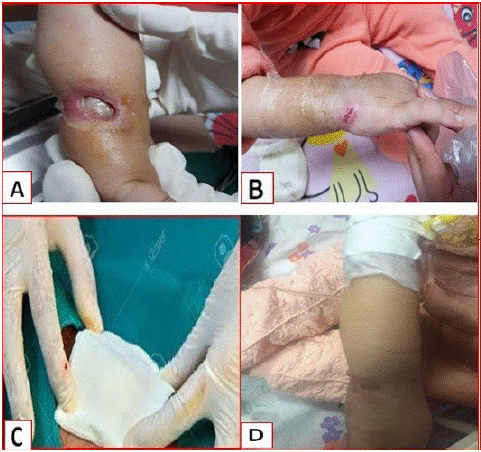
Clinical Image
Austin J Clin Case Rep. 2023; 10(6): 1297.
Aminotic Membrane Dressing for Chemotherapy Extravasation Wounds
Abdolkarimi Babak¹*; Khadijeh Ansari²
¹Assistant Professor of Pediatric Hematology-Oncology, Lorestan University of Medical Sciences, Khoramabad, Iran
²Pediatric Oncology Nurse, Lorestan University of Medical Sciences, Khoramabad, Iran
*Corresponding author: Babak Abdolkarimi Assistant Professor of Pediatric Hematology-Oncology, Lorestan University of Medical Sciences, Khoramabad, Iran. Tel: 09183605274 Email: b.abdolkarimi@yahoo.com
Received: July 03, 2023 Accepted: August 05, 2023 Published: August 12, 2023
Clinical Image
The human amniotic membrane surrounds and protects the developing fetus and separate the mother and fetus. It has several properties that make it particularly suitable for wound healing. This dressing contains significant amounts of cytokines and growth factors essential for tissue repair. Traditionally, the amniotic membrane has been used for wounds healing in burn wounds and diabetic foot ulcers. The amniotic membrane may be effective for deep or incurable wounds [2]. Chemotherapy extravasation is an accidental leak of chemotherapy drug in the subcutaneous tissue around the intravenous line. There is no standard treatment for these wounds [3].
Human amniotic membrane dressing
Amicore: This product is a dried amniotic fluid that is spread on sterile gas. Amicore is used as a biological dressing to treat skin wounds such as burns, chronic and acute wounds that have a difficult healing process and after surgery to cover the surgical site to accelerate healing.
Equirage-C: This product is a wet amniotic fluid spread on sterile nitrocellulose paper and stored in a freezer. Ecurge-C as a bio-dressing is mainly used in burns and eye surgeries. It is also used as a carrier for cell transfer in cell culture.
Equirage-C: This product is a dry amniotic fluid placed in a lyophilizer. Can be stored at any temperature.
Acellular: This product is a moist amniotic fluid whose epithelial cell layer is removed, and finally the sample is nitrocellulose on paper. In cell culture, it is used as a cell scaffold or as a carrier to deliver the cell to the site and also as a cell scaffold or as a carrier to deliver the cell to the site and also as a dressing to cover burn wounds.
We report a new option for healing chemotherapy extravasation wounds. These images described A 3-year-old girl with acute lymphocytic leukemia was complicated by a full-thickness wound due to vincristine extravasation (Figure A). This patient was treated with an amniotic membrane dressing. The dressing covers on the wound without any fender. The wound was initially stilled by intravenous Clindamycin (15 mg/kg q6h) base on wound bacterial culture and daily washing by TauroLock™-Hep500. After wound sterilization, amniotic membrane was embedded on the wound. (Minimally after 2 days) The dressing covers (Amicore type) on the wound without any fender. Complete recovery pull over 3 weeks (Figure D) Therefore, we believe that using of dehydrated amniotic membranes is a new excellent method for wounds healing caused by chemotherapy drug extravasation.

Figure 1:
References
- Fetterolf D, Snyder R. Scientific and Clinical Support for the Use of Dehydrated Amniotic Membrane in Wound Management. Wounds J. 2012; 24: 299-307.
- Zelen C, Serena T. Amniotic Membrane: Can it facilitate healing? Podiatry Today. 2015; 28. Available at http://www.podiatrytoday.com/amniotic-membrane-can-it-facilitate-healing
- JA Pérez Fidalgo, L García Fabregat, A Cervantes, A Margulies, C Vidall, et al. Management of chemotherapy extravasation: ESMO– EONS Clinical Practice Guidelines. Annals of Oncology. 2012; 23: 167–173.